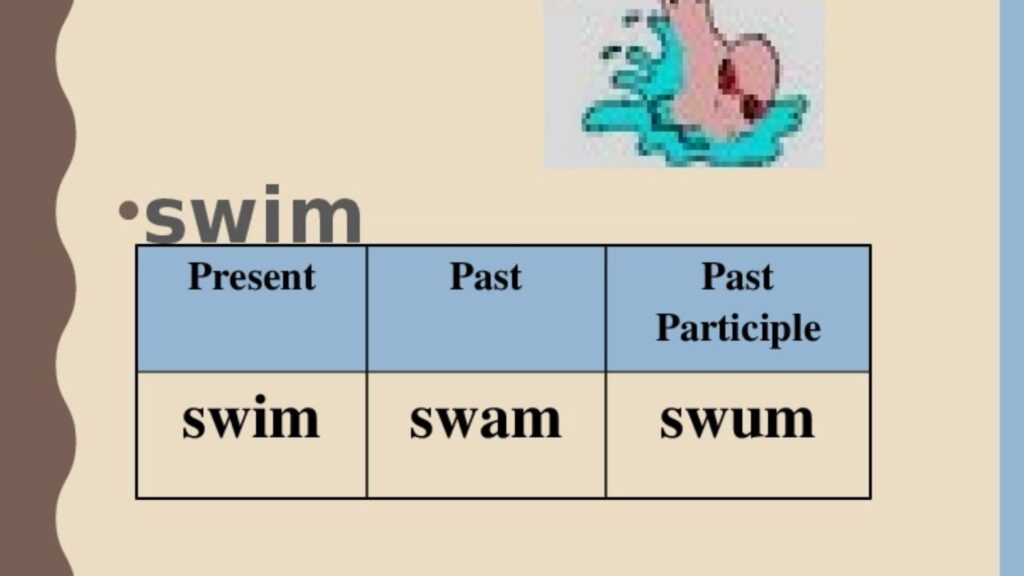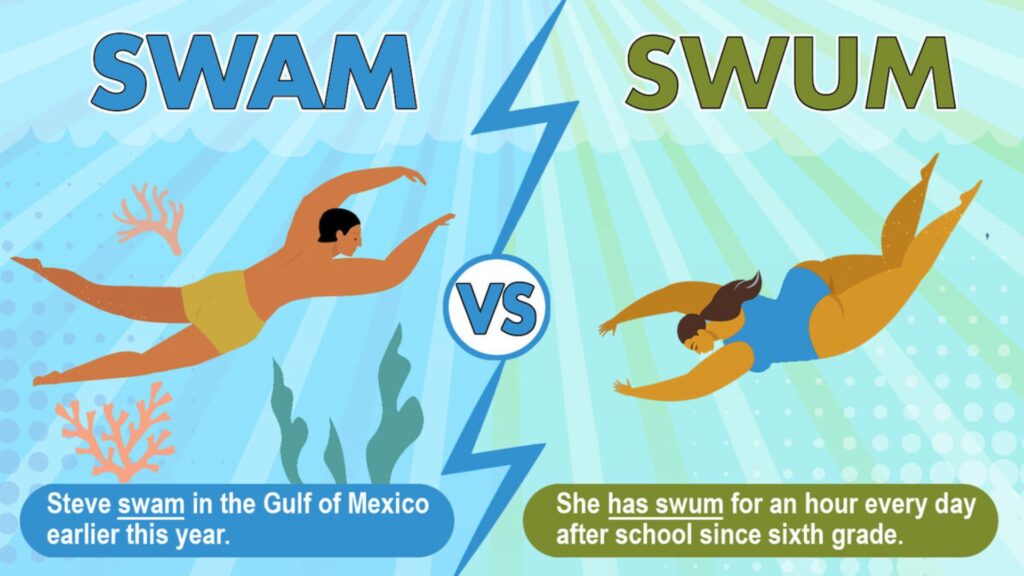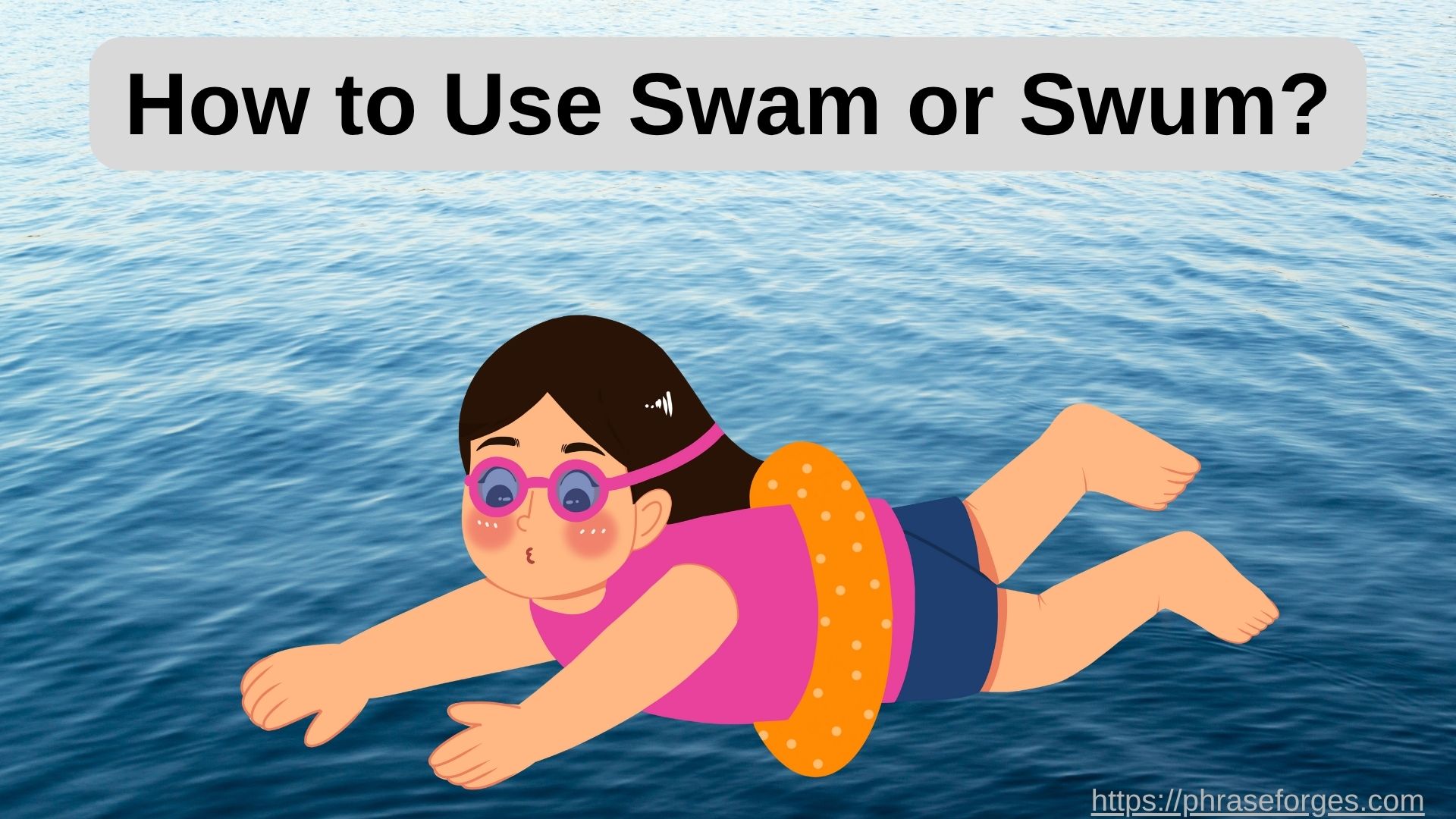Ever caught yourself wondering, “Is it swam or swum?” You’re not alone. English is filled with irregular verbs that break predictable rules, and “swim” is one of them. If you’ve ever paused mid-sentence trying to decide between “I have swam” or “I have swum,” this article is for you.
We’ll break it down clearly with rules, examples, email scenarios, and even a few memory tricks. By the end, you’ll know exactly how to use swam or swum like a native speaker.
✅ Simple Definition + Usage Overview

Let’s start with the basic forms of the verb to swim:
| Verb Form | Example |
|---|---|
| Base form | I swim every day. |
| Simple past | Yesterday, I swam for an hour. |
| Past participle | I have swum across this lake before. |
The key distinction?
- Swam is used as the simple past tense (no helping verbs).
- Swum is the past participle, used with have, has, or had.
✅ Clear Rules & Patterns
Use “swam” when:
You’re just describing something that happened in the past no helper verbs involved.
“Last summer, we swam in every lake we passed.”
Use “swum” when:
You need the past participle which means it follows a helping verb like have, has, or had.
“I have swum in cold mountain streams before.”
That one helper verb makes all the difference.
✅ Bulleted Rules with Do’s & Don’ts
Here’s a breakdown you can remember:
✔️ Do use “swam” when:
- You’re writing or speaking in the simple past tense.
- No helping verb is used before it.
Examples:
- “She swam across the bay.”
- “We swam all afternoon.”
❌ Don’t use “swam” with helping verbs like have/has/had.
❌ “They have swam all morning.”
✅ “They have swum all morning.”
✔️ Do use “swum” when:
- The verb follows have, has, or had (perfect tenses).
- You want to sound grammatically correct and fluent.
✅ Multiple Example Sentences
Here’s a side-by-side comparison to help:
| Tense | Correct Usage | Incorrect Usage |
|---|---|---|
| Simple Past | “She swam this morning.” | “She has swam this morning.” ❌ |
| Present Perfect | “She has swum this morning.” | “She has swam this morning.” ❌ |
| Past Perfect | “They had swum already.” | “They had swam already.” ❌ |
Always watch for have/has/had they signal you need swum, not swam.
✅ Before/After Examples in Everyday and Formal Contexts
📨 Casual Email Example: Using “Swam”
Subject: Our Weekend Adventure
Hey Jake,
Saturday was amazing! I still can’t believe we swam to that tiny island. I thought I was going to be too tired to make it back, but we crushed it.
Next time, we should bring snorkeling gear.
Cheers,
Emma
📧 Professional Email Example: Using “Swum”
Subject: Annual Wellness Retreat Feedback
Hi Andrea,
Thanks for organizing the retreat. I appreciated the chance to unwind, especially during the lake activities. It had been years since I’d swum that far without stopping, and it felt fantastic!
Looking forward to next year’s event.
Warm regards,
Marcus
✅ Common Mistakes & Fixes
Even native speakers mess this up. Let’s fix a few of the most frequent offenders:
❌ Incorrect:
“I have swam in this pool before.”
✅ Correct:
“I have swum in this pool before.”
❌ Incorrect:
“He had swam for hours before resting.”
✅ Correct:
“He had swum for hours before resting.”
Remember: If there’s a helper verb, “swum” is the form you need.
✅ Keyword + Intro Explanation
So, how do you know how to use swam or swum correctly every time?
Ask yourself:
- Does this sentence have have, has, or had?
- ✅ Use swum
- No helping verb?
- ✅ Use swam
That’s it! Easy, right?
✅ Analogy to Make It Stick

Here’s a simple comparison to remember the rule:
Imagine “swam” is like a snapshot a single action in the past.
“Swum” is like a highlight reel a collection of experiences that connect with the present or past events.
So if you’re recalling something in the past that still matters now, you’ll likely need swum.
✅ Scenario: Interview Response
Question: Tell us about a personal challenge you’ve overcome.
Answer:
“One summer, I swam across the lake every morning as part of my training routine.”
Or…
“I’ve swum across that lake many times, and each time it pushes my limits further.”
Both are grammatically correct but notice how the second connects to present relevance using “have swum.”
✅ Fun With Idioms: “Swim” in Everyday Expressions
While you’re mastering swim conjugations, don’t forget about fun idioms:
- Sink or swim – you succeed or fail by your own effort.
- In the swim of things – actively involved or up-to-date.
- Swim against the current – going against popular opinion or the norm.
Just be careful: these idioms use “swim” in a figurative sense they’re not about literal water!
✅ Quick Reference Table
Here’s a cheat sheet to keep handy:
| Verb Form | When to Use | Example |
|---|---|---|
| Swim | Present | “I swim every weekend.” |
| Swam | Simple Past | “Last Saturday, I swam in the river.” |
| Swum | Past Participle (w/ helping verb) | “I have swum in the ocean many times.” |
✅ Common Confusion: Swam vs. Swimmed
Some learners mistakenly try to regularize “swim” into “swimmed.” But that form doesn’t exist in standard English.
❌ “He swimmed fast.”
✅ “He swam fast.”
“Swimmed” is grammatically incorrect no exceptions.
✅ Final Thoughts

Knowing how to use swam or swum can elevate your writing and speech. These forms are part of English’s irregular verb system no -ed endings here. But once you learn the pattern, it becomes second nature.
Remember:
- No helper verb? → Use swam
- Helper verb (have/has/had)? → Use swum
With this guide, you’re now fluent in one of English’s most slippery verb forms.
So the next time you’re writing an email or chatting about your last vacation, you’ll know exactly what to say:
“I swam in that river last year.”
“I have swum in mountain streams since I was a kid.”

